Banking Risks: Credit Risk Assessment and CVA Analysis
VerifiedAdded on 2023/05/29
|8
|1820
|244
Report
AI Summary
This report provides an in-depth analysis of banking risks, focusing on credit risk assessment and credit value adjustment (CVA). It begins by examining the Bank of International Settlements (BIS)'s preferred credit risk measurement approach, highlighting the importance of credit ratings and the Know Your Customer (KYC) norms in assessing creditworthiness. The report then delves into the evaluation of credit value adjustment (CVA), tracing its origins to counterparty credit risk during the 2007-08 financial crisis. It discusses the challenges associated with implementing CVA, such as the lack of robust credit management tools and difficulties in calculating and reporting potential future exposures. The report concludes by emphasizing the importance of credit risk management and the role of credit ratings in minimizing banking risks, offering valuable insights for financial institutions and students alike. The report uses various sources, including academic research papers and industry reports, to support its findings.

Running head: BANKING RISKS
Banking Risks
Name of the Student:
Name of the University:
Author’s Note:
Banking Risks
Name of the Student:
Name of the University:
Author’s Note:
Paraphrase This Document
Need a fresh take? Get an instant paraphrase of this document with our AI Paraphraser
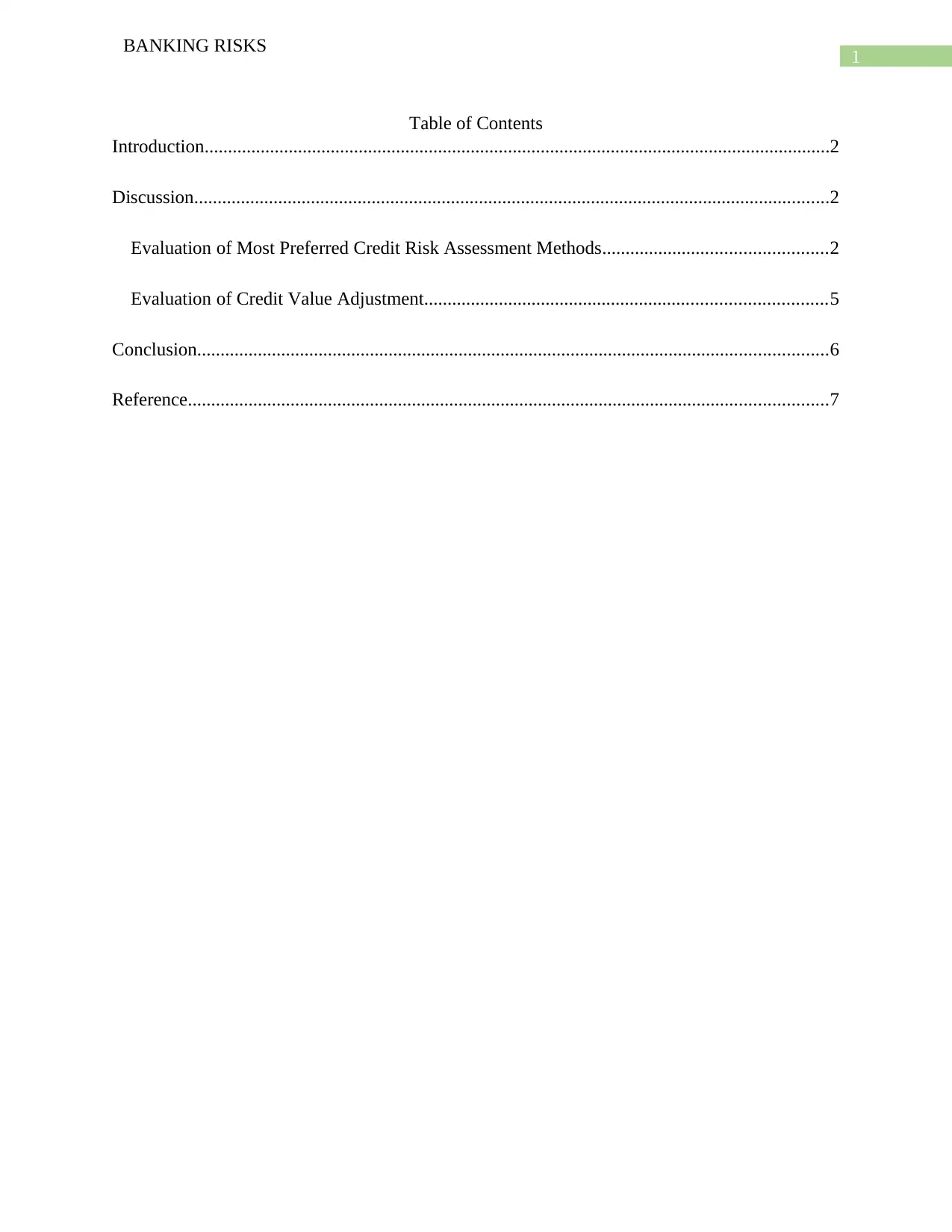
1
BANKING RISKS
Table of Contents
Introduction......................................................................................................................................2
Discussion........................................................................................................................................2
Evaluation of Most Preferred Credit Risk Assessment Methods................................................2
Evaluation of Credit Value Adjustment......................................................................................5
Conclusion.......................................................................................................................................6
Reference.........................................................................................................................................7
BANKING RISKS
Table of Contents
Introduction......................................................................................................................................2
Discussion........................................................................................................................................2
Evaluation of Most Preferred Credit Risk Assessment Methods................................................2
Evaluation of Credit Value Adjustment......................................................................................5
Conclusion.......................................................................................................................................6
Reference.........................................................................................................................................7
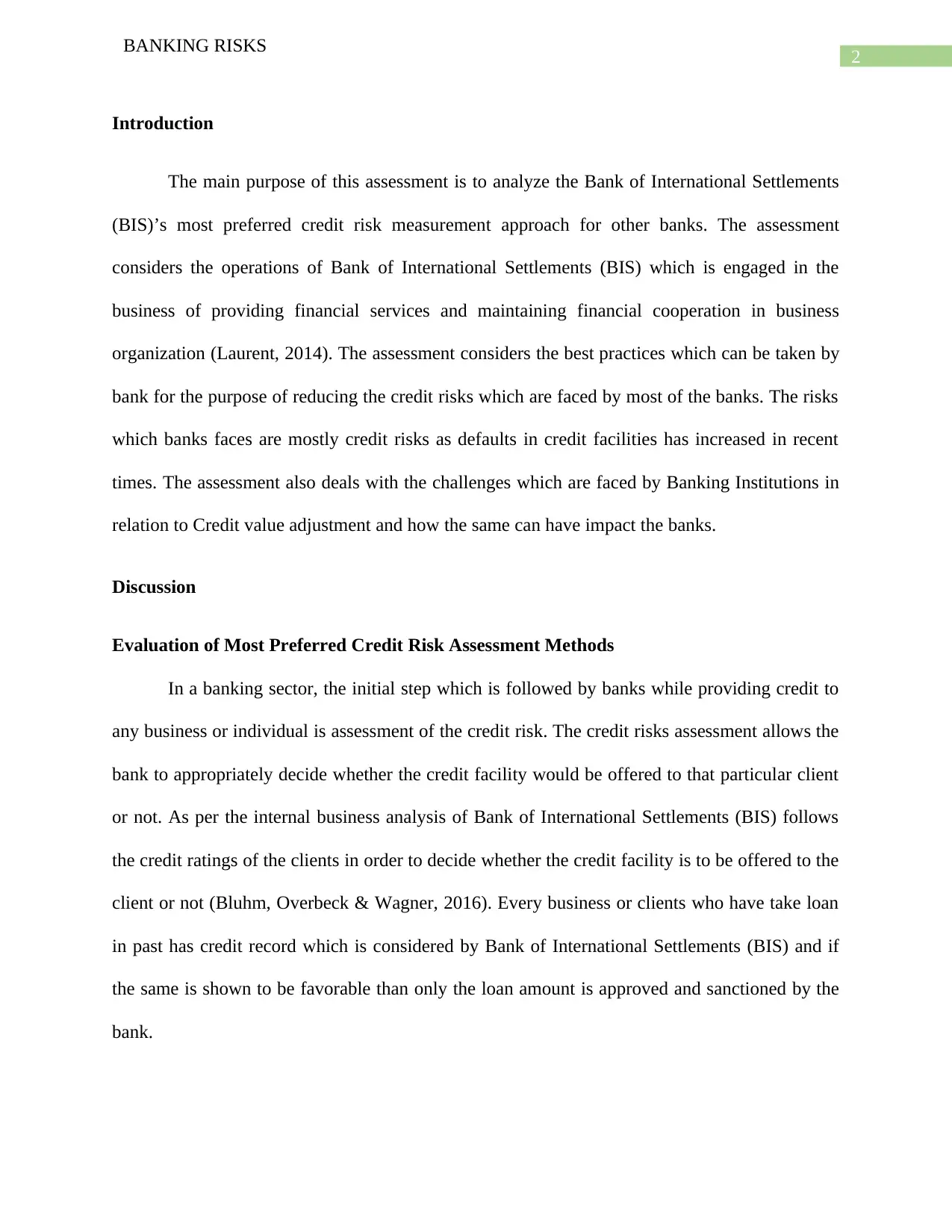
2
BANKING RISKS
Introduction
The main purpose of this assessment is to analyze the Bank of International Settlements
(BIS)’s most preferred credit risk measurement approach for other banks. The assessment
considers the operations of Bank of International Settlements (BIS) which is engaged in the
business of providing financial services and maintaining financial cooperation in business
organization (Laurent, 2014). The assessment considers the best practices which can be taken by
bank for the purpose of reducing the credit risks which are faced by most of the banks. The risks
which banks faces are mostly credit risks as defaults in credit facilities has increased in recent
times. The assessment also deals with the challenges which are faced by Banking Institutions in
relation to Credit value adjustment and how the same can have impact the banks.
Discussion
Evaluation of Most Preferred Credit Risk Assessment Methods
In a banking sector, the initial step which is followed by banks while providing credit to
any business or individual is assessment of the credit risk. The credit risks assessment allows the
bank to appropriately decide whether the credit facility would be offered to that particular client
or not. As per the internal business analysis of Bank of International Settlements (BIS) follows
the credit ratings of the clients in order to decide whether the credit facility is to be offered to the
client or not (Bluhm, Overbeck & Wagner, 2016). Every business or clients who have take loan
in past has credit record which is considered by Bank of International Settlements (BIS) and if
the same is shown to be favorable than only the loan amount is approved and sanctioned by the
bank.
BANKING RISKS
Introduction
The main purpose of this assessment is to analyze the Bank of International Settlements
(BIS)’s most preferred credit risk measurement approach for other banks. The assessment
considers the operations of Bank of International Settlements (BIS) which is engaged in the
business of providing financial services and maintaining financial cooperation in business
organization (Laurent, 2014). The assessment considers the best practices which can be taken by
bank for the purpose of reducing the credit risks which are faced by most of the banks. The risks
which banks faces are mostly credit risks as defaults in credit facilities has increased in recent
times. The assessment also deals with the challenges which are faced by Banking Institutions in
relation to Credit value adjustment and how the same can have impact the banks.
Discussion
Evaluation of Most Preferred Credit Risk Assessment Methods
In a banking sector, the initial step which is followed by banks while providing credit to
any business or individual is assessment of the credit risk. The credit risks assessment allows the
bank to appropriately decide whether the credit facility would be offered to that particular client
or not. As per the internal business analysis of Bank of International Settlements (BIS) follows
the credit ratings of the clients in order to decide whether the credit facility is to be offered to the
client or not (Bluhm, Overbeck & Wagner, 2016). Every business or clients who have take loan
in past has credit record which is considered by Bank of International Settlements (BIS) and if
the same is shown to be favorable than only the loan amount is approved and sanctioned by the
bank.
⊘ This is a preview!⊘
Do you want full access?
Subscribe today to unlock all pages.

Trusted by 1+ million students worldwide
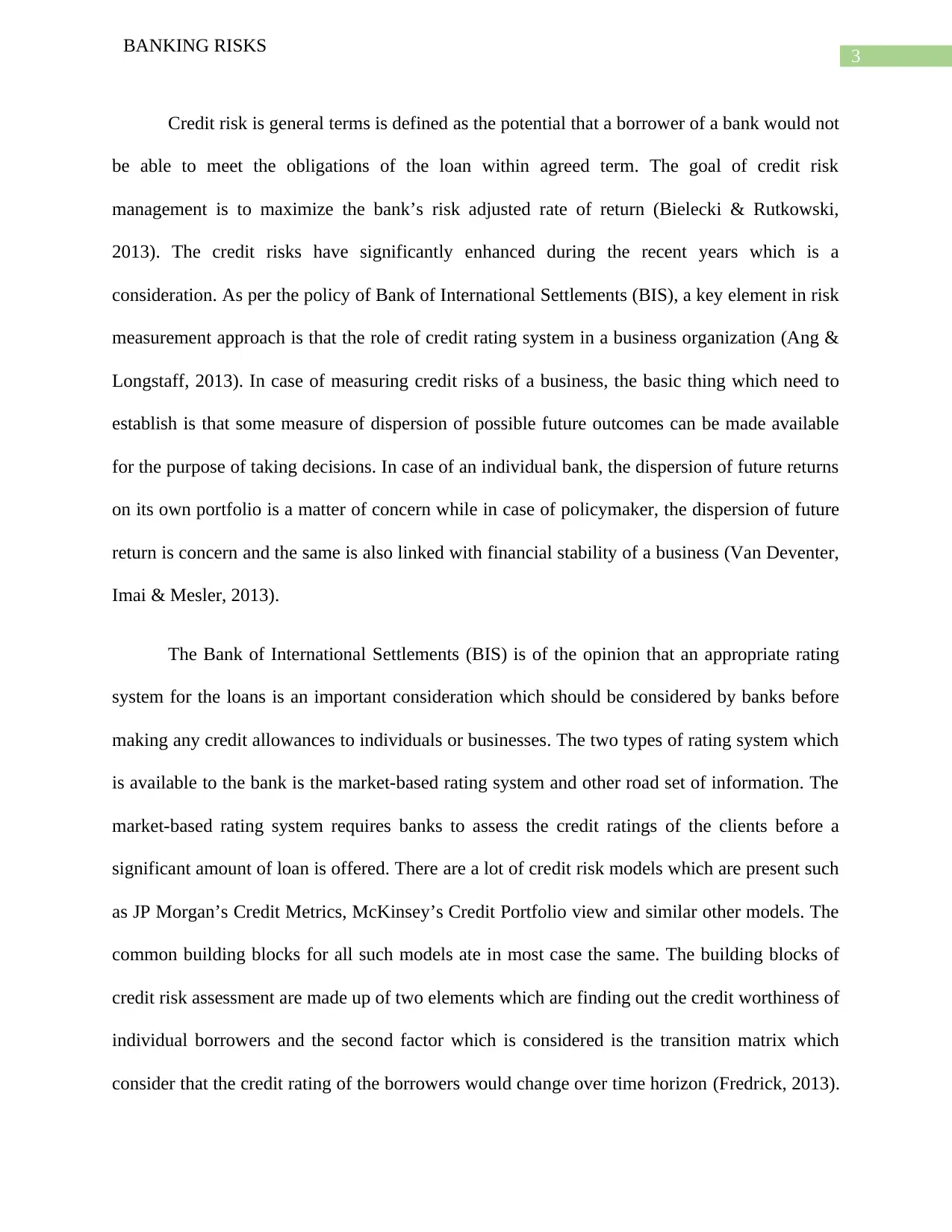
3
BANKING RISKS
Credit risk is general terms is defined as the potential that a borrower of a bank would not
be able to meet the obligations of the loan within agreed term. The goal of credit risk
management is to maximize the bank’s risk adjusted rate of return (Bielecki & Rutkowski,
2013). The credit risks have significantly enhanced during the recent years which is a
consideration. As per the policy of Bank of International Settlements (BIS), a key element in risk
measurement approach is that the role of credit rating system in a business organization (Ang &
Longstaff, 2013). In case of measuring credit risks of a business, the basic thing which need to
establish is that some measure of dispersion of possible future outcomes can be made available
for the purpose of taking decisions. In case of an individual bank, the dispersion of future returns
on its own portfolio is a matter of concern while in case of policymaker, the dispersion of future
return is concern and the same is also linked with financial stability of a business (Van Deventer,
Imai & Mesler, 2013).
The Bank of International Settlements (BIS) is of the opinion that an appropriate rating
system for the loans is an important consideration which should be considered by banks before
making any credit allowances to individuals or businesses. The two types of rating system which
is available to the bank is the market-based rating system and other road set of information. The
market-based rating system requires banks to assess the credit ratings of the clients before a
significant amount of loan is offered. There are a lot of credit risk models which are present such
as JP Morgan’s Credit Metrics, McKinsey’s Credit Portfolio view and similar other models. The
common building blocks for all such models ate in most case the same. The building blocks of
credit risk assessment are made up of two elements which are finding out the credit worthiness of
individual borrowers and the second factor which is considered is the transition matrix which
consider that the credit rating of the borrowers would change over time horizon (Fredrick, 2013).
BANKING RISKS
Credit risk is general terms is defined as the potential that a borrower of a bank would not
be able to meet the obligations of the loan within agreed term. The goal of credit risk
management is to maximize the bank’s risk adjusted rate of return (Bielecki & Rutkowski,
2013). The credit risks have significantly enhanced during the recent years which is a
consideration. As per the policy of Bank of International Settlements (BIS), a key element in risk
measurement approach is that the role of credit rating system in a business organization (Ang &
Longstaff, 2013). In case of measuring credit risks of a business, the basic thing which need to
establish is that some measure of dispersion of possible future outcomes can be made available
for the purpose of taking decisions. In case of an individual bank, the dispersion of future returns
on its own portfolio is a matter of concern while in case of policymaker, the dispersion of future
return is concern and the same is also linked with financial stability of a business (Van Deventer,
Imai & Mesler, 2013).
The Bank of International Settlements (BIS) is of the opinion that an appropriate rating
system for the loans is an important consideration which should be considered by banks before
making any credit allowances to individuals or businesses. The two types of rating system which
is available to the bank is the market-based rating system and other road set of information. The
market-based rating system requires banks to assess the credit ratings of the clients before a
significant amount of loan is offered. There are a lot of credit risk models which are present such
as JP Morgan’s Credit Metrics, McKinsey’s Credit Portfolio view and similar other models. The
common building blocks for all such models ate in most case the same. The building blocks of
credit risk assessment are made up of two elements which are finding out the credit worthiness of
individual borrowers and the second factor which is considered is the transition matrix which
consider that the credit rating of the borrowers would change over time horizon (Fredrick, 2013).
Paraphrase This Document
Need a fresh take? Get an instant paraphrase of this document with our AI Paraphraser
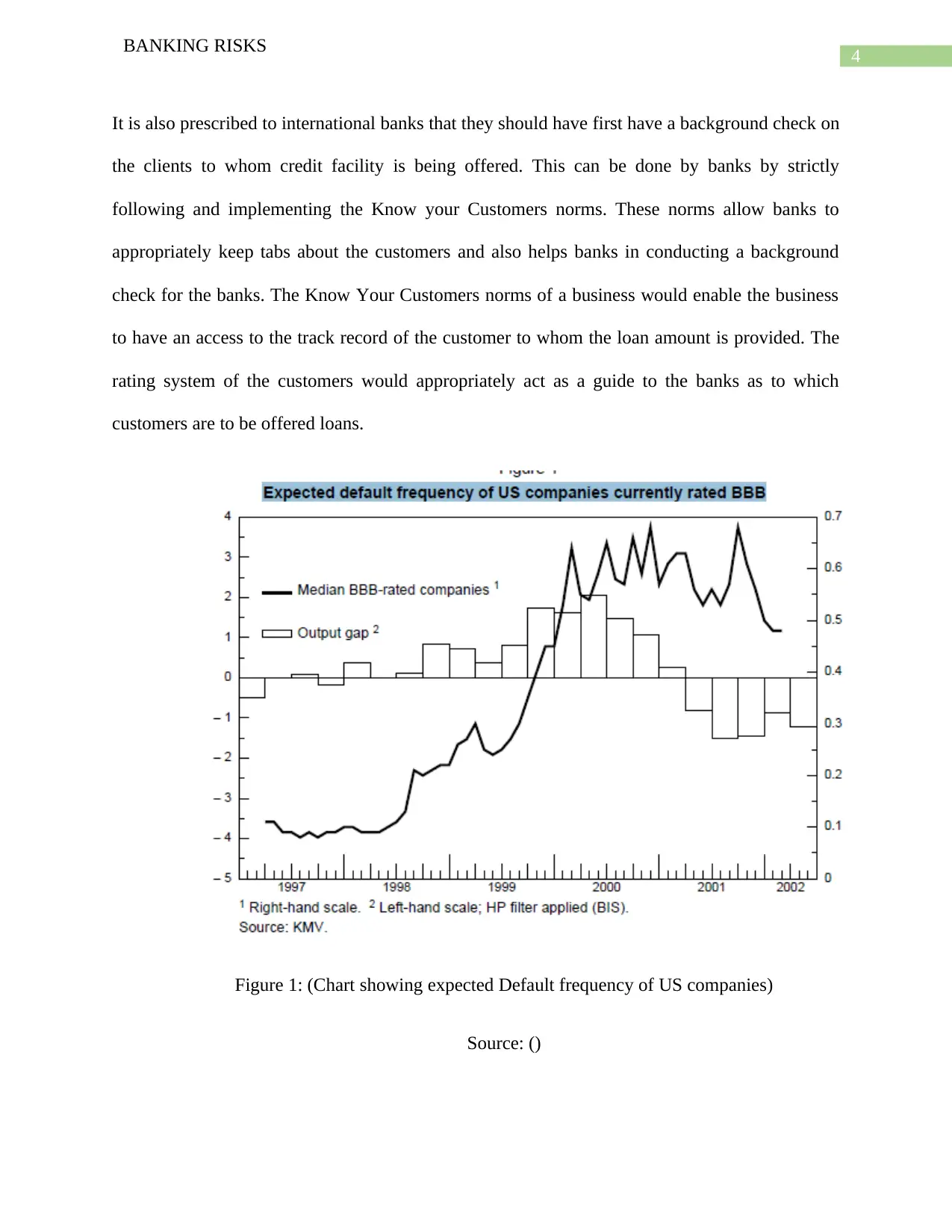
4
BANKING RISKS
It is also prescribed to international banks that they should have first have a background check on
the clients to whom credit facility is being offered. This can be done by banks by strictly
following and implementing the Know your Customers norms. These norms allow banks to
appropriately keep tabs about the customers and also helps banks in conducting a background
check for the banks. The Know Your Customers norms of a business would enable the business
to have an access to the track record of the customer to whom the loan amount is provided. The
rating system of the customers would appropriately act as a guide to the banks as to which
customers are to be offered loans.
Figure 1: (Chart showing expected Default frequency of US companies)
Source: ()
BANKING RISKS
It is also prescribed to international banks that they should have first have a background check on
the clients to whom credit facility is being offered. This can be done by banks by strictly
following and implementing the Know your Customers norms. These norms allow banks to
appropriately keep tabs about the customers and also helps banks in conducting a background
check for the banks. The Know Your Customers norms of a business would enable the business
to have an access to the track record of the customer to whom the loan amount is provided. The
rating system of the customers would appropriately act as a guide to the banks as to which
customers are to be offered loans.
Figure 1: (Chart showing expected Default frequency of US companies)
Source: ()
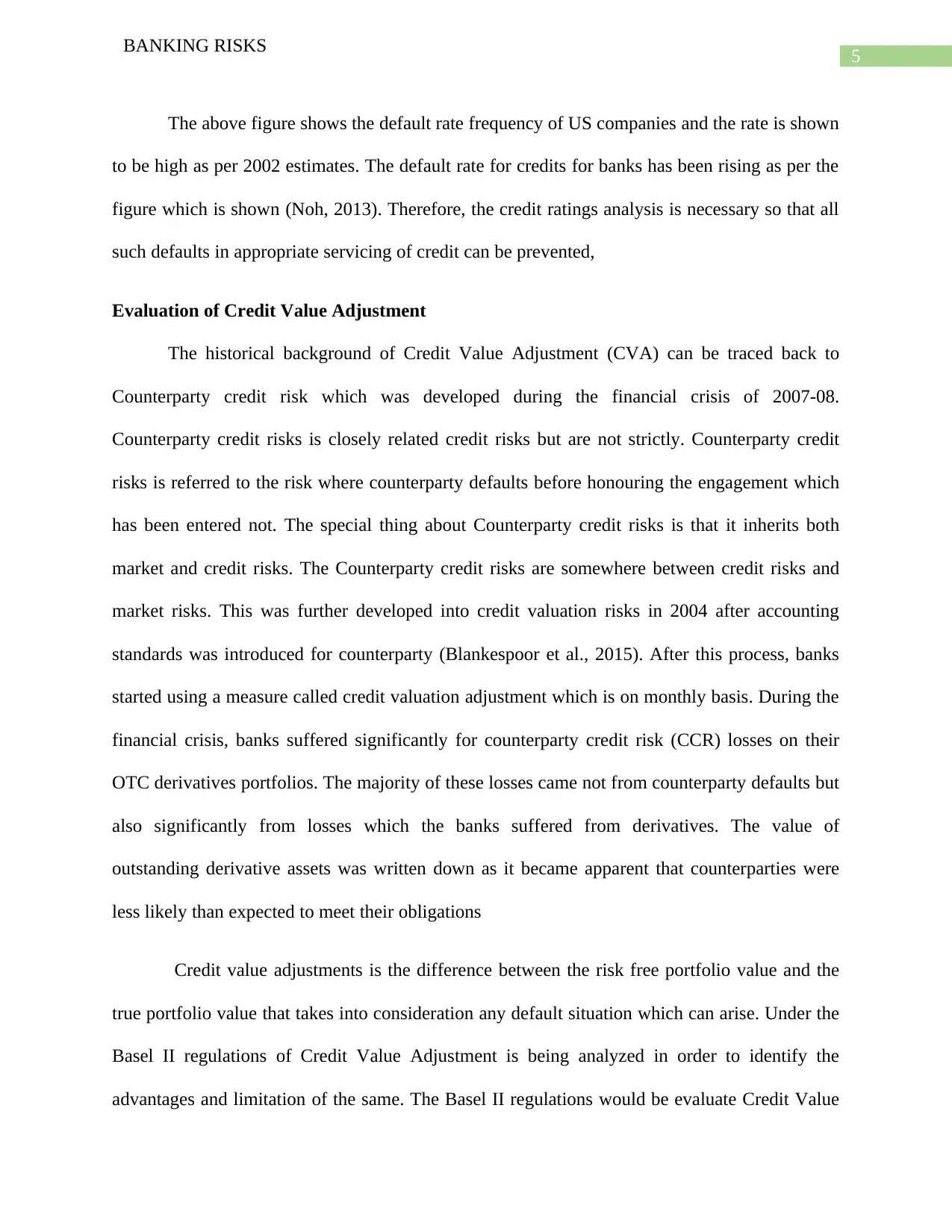
5
BANKING RISKS
The above figure shows the default rate frequency of US companies and the rate is shown
to be high as per 2002 estimates. The default rate for credits for banks has been rising as per the
figure which is shown (Noh, 2013). Therefore, the credit ratings analysis is necessary so that all
such defaults in appropriate servicing of credit can be prevented,
Evaluation of Credit Value Adjustment
The historical background of Credit Value Adjustment (CVA) can be traced back to
Counterparty credit risk which was developed during the financial crisis of 2007-08.
Counterparty credit risks is closely related credit risks but are not strictly. Counterparty credit
risks is referred to the risk where counterparty defaults before honouring the engagement which
has been entered not. The special thing about Counterparty credit risks is that it inherits both
market and credit risks. The Counterparty credit risks are somewhere between credit risks and
market risks. This was further developed into credit valuation risks in 2004 after accounting
standards was introduced for counterparty (Blankespoor et al., 2015). After this process, banks
started using a measure called credit valuation adjustment which is on monthly basis. During the
financial crisis, banks suffered significantly for counterparty credit risk (CCR) losses on their
OTC derivatives portfolios. The majority of these losses came not from counterparty defaults but
also significantly from losses which the banks suffered from derivatives. The value of
outstanding derivative assets was written down as it became apparent that counterparties were
less likely than expected to meet their obligations
Credit value adjustments is the difference between the risk free portfolio value and the
true portfolio value that takes into consideration any default situation which can arise. Under the
Basel II regulations of Credit Value Adjustment is being analyzed in order to identify the
advantages and limitation of the same. The Basel II regulations would be evaluate Credit Value
BANKING RISKS
The above figure shows the default rate frequency of US companies and the rate is shown
to be high as per 2002 estimates. The default rate for credits for banks has been rising as per the
figure which is shown (Noh, 2013). Therefore, the credit ratings analysis is necessary so that all
such defaults in appropriate servicing of credit can be prevented,
Evaluation of Credit Value Adjustment
The historical background of Credit Value Adjustment (CVA) can be traced back to
Counterparty credit risk which was developed during the financial crisis of 2007-08.
Counterparty credit risks is closely related credit risks but are not strictly. Counterparty credit
risks is referred to the risk where counterparty defaults before honouring the engagement which
has been entered not. The special thing about Counterparty credit risks is that it inherits both
market and credit risks. The Counterparty credit risks are somewhere between credit risks and
market risks. This was further developed into credit valuation risks in 2004 after accounting
standards was introduced for counterparty (Blankespoor et al., 2015). After this process, banks
started using a measure called credit valuation adjustment which is on monthly basis. During the
financial crisis, banks suffered significantly for counterparty credit risk (CCR) losses on their
OTC derivatives portfolios. The majority of these losses came not from counterparty defaults but
also significantly from losses which the banks suffered from derivatives. The value of
outstanding derivative assets was written down as it became apparent that counterparties were
less likely than expected to meet their obligations
Credit value adjustments is the difference between the risk free portfolio value and the
true portfolio value that takes into consideration any default situation which can arise. Under the
Basel II regulations of Credit Value Adjustment is being analyzed in order to identify the
advantages and limitation of the same. The Basel II regulations would be evaluate Credit Value
⊘ This is a preview!⊘
Do you want full access?
Subscribe today to unlock all pages.

Trusted by 1+ million students worldwide
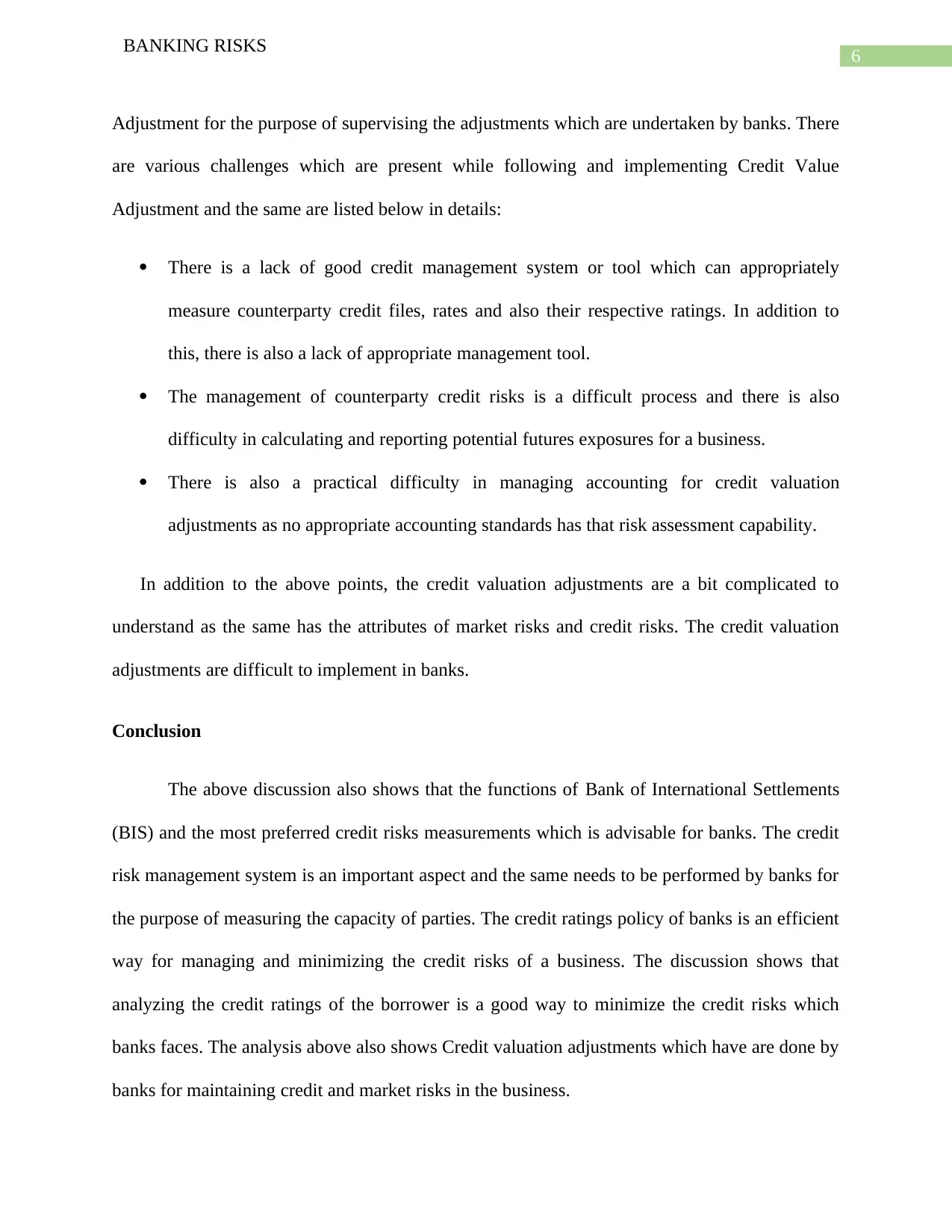
6
BANKING RISKS
Adjustment for the purpose of supervising the adjustments which are undertaken by banks. There
are various challenges which are present while following and implementing Credit Value
Adjustment and the same are listed below in details:
There is a lack of good credit management system or tool which can appropriately
measure counterparty credit files, rates and also their respective ratings. In addition to
this, there is also a lack of appropriate management tool.
The management of counterparty credit risks is a difficult process and there is also
difficulty in calculating and reporting potential futures exposures for a business.
There is also a practical difficulty in managing accounting for credit valuation
adjustments as no appropriate accounting standards has that risk assessment capability.
In addition to the above points, the credit valuation adjustments are a bit complicated to
understand as the same has the attributes of market risks and credit risks. The credit valuation
adjustments are difficult to implement in banks.
Conclusion
The above discussion also shows that the functions of Bank of International Settlements
(BIS) and the most preferred credit risks measurements which is advisable for banks. The credit
risk management system is an important aspect and the same needs to be performed by banks for
the purpose of measuring the capacity of parties. The credit ratings policy of banks is an efficient
way for managing and minimizing the credit risks of a business. The discussion shows that
analyzing the credit ratings of the borrower is a good way to minimize the credit risks which
banks faces. The analysis above also shows Credit valuation adjustments which have are done by
banks for maintaining credit and market risks in the business.
BANKING RISKS
Adjustment for the purpose of supervising the adjustments which are undertaken by banks. There
are various challenges which are present while following and implementing Credit Value
Adjustment and the same are listed below in details:
There is a lack of good credit management system or tool which can appropriately
measure counterparty credit files, rates and also their respective ratings. In addition to
this, there is also a lack of appropriate management tool.
The management of counterparty credit risks is a difficult process and there is also
difficulty in calculating and reporting potential futures exposures for a business.
There is also a practical difficulty in managing accounting for credit valuation
adjustments as no appropriate accounting standards has that risk assessment capability.
In addition to the above points, the credit valuation adjustments are a bit complicated to
understand as the same has the attributes of market risks and credit risks. The credit valuation
adjustments are difficult to implement in banks.
Conclusion
The above discussion also shows that the functions of Bank of International Settlements
(BIS) and the most preferred credit risks measurements which is advisable for banks. The credit
risk management system is an important aspect and the same needs to be performed by banks for
the purpose of measuring the capacity of parties. The credit ratings policy of banks is an efficient
way for managing and minimizing the credit risks of a business. The discussion shows that
analyzing the credit ratings of the borrower is a good way to minimize the credit risks which
banks faces. The analysis above also shows Credit valuation adjustments which have are done by
banks for maintaining credit and market risks in the business.
Paraphrase This Document
Need a fresh take? Get an instant paraphrase of this document with our AI Paraphraser
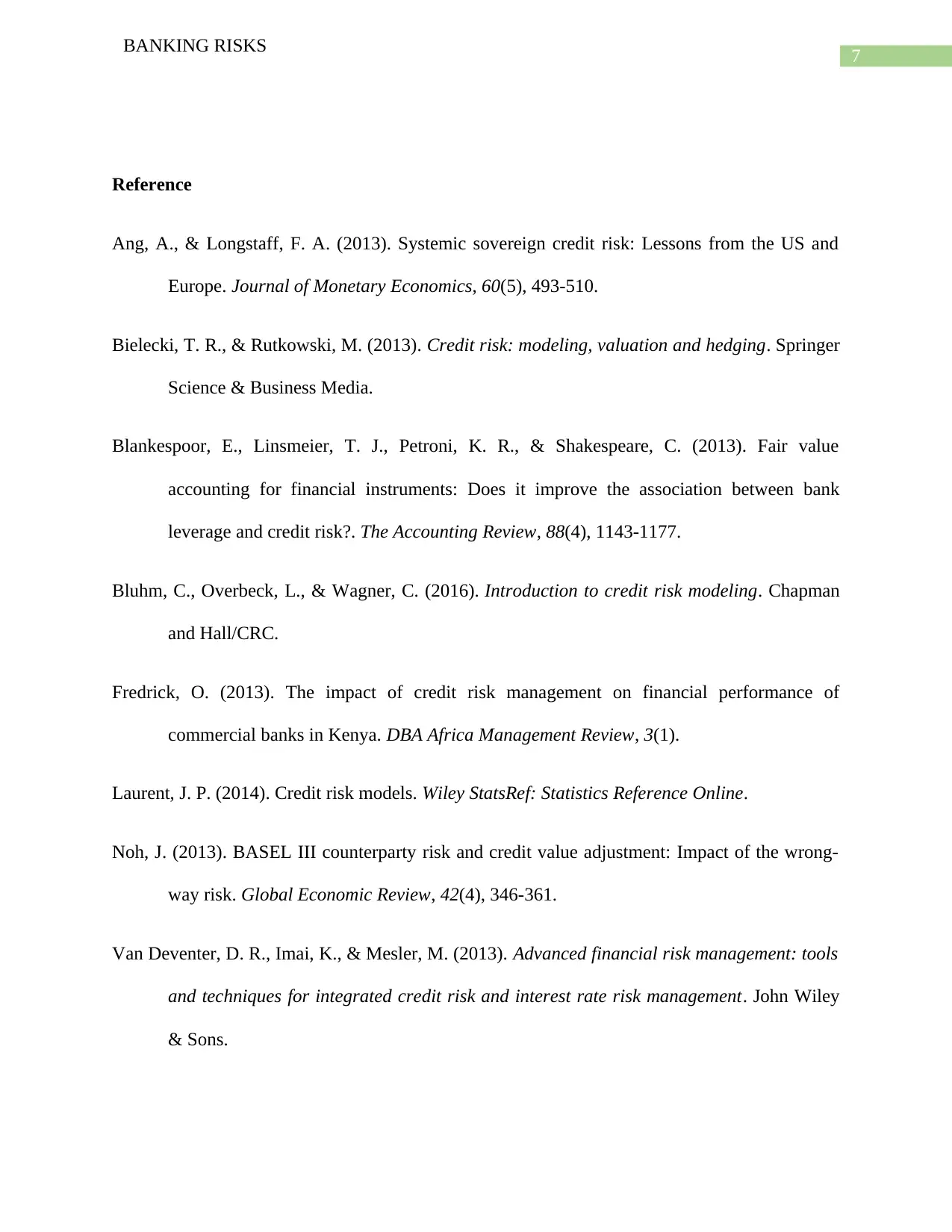
7
BANKING RISKS
Reference
Ang, A., & Longstaff, F. A. (2013). Systemic sovereign credit risk: Lessons from the US and
Europe. Journal of Monetary Economics, 60(5), 493-510.
Bielecki, T. R., & Rutkowski, M. (2013). Credit risk: modeling, valuation and hedging. Springer
Science & Business Media.
Blankespoor, E., Linsmeier, T. J., Petroni, K. R., & Shakespeare, C. (2013). Fair value
accounting for financial instruments: Does it improve the association between bank
leverage and credit risk?. The Accounting Review, 88(4), 1143-1177.
Bluhm, C., Overbeck, L., & Wagner, C. (2016). Introduction to credit risk modeling. Chapman
and Hall/CRC.
Fredrick, O. (2013). The impact of credit risk management on financial performance of
commercial banks in Kenya. DBA Africa Management Review, 3(1).
Laurent, J. P. (2014). Credit risk models. Wiley StatsRef: Statistics Reference Online.
Noh, J. (2013). BASEL III counterparty risk and credit value adjustment: Impact of the wrong-
way risk. Global Economic Review, 42(4), 346-361.
Van Deventer, D. R., Imai, K., & Mesler, M. (2013). Advanced financial risk management: tools
and techniques for integrated credit risk and interest rate risk management. John Wiley
& Sons.
BANKING RISKS
Reference
Ang, A., & Longstaff, F. A. (2013). Systemic sovereign credit risk: Lessons from the US and
Europe. Journal of Monetary Economics, 60(5), 493-510.
Bielecki, T. R., & Rutkowski, M. (2013). Credit risk: modeling, valuation and hedging. Springer
Science & Business Media.
Blankespoor, E., Linsmeier, T. J., Petroni, K. R., & Shakespeare, C. (2013). Fair value
accounting for financial instruments: Does it improve the association between bank
leverage and credit risk?. The Accounting Review, 88(4), 1143-1177.
Bluhm, C., Overbeck, L., & Wagner, C. (2016). Introduction to credit risk modeling. Chapman
and Hall/CRC.
Fredrick, O. (2013). The impact of credit risk management on financial performance of
commercial banks in Kenya. DBA Africa Management Review, 3(1).
Laurent, J. P. (2014). Credit risk models. Wiley StatsRef: Statistics Reference Online.
Noh, J. (2013). BASEL III counterparty risk and credit value adjustment: Impact of the wrong-
way risk. Global Economic Review, 42(4), 346-361.
Van Deventer, D. R., Imai, K., & Mesler, M. (2013). Advanced financial risk management: tools
and techniques for integrated credit risk and interest rate risk management. John Wiley
& Sons.
1 out of 8
Related Documents
Your All-in-One AI-Powered Toolkit for Academic Success.
+13062052269
info@desklib.com
Available 24*7 on WhatsApp / Email
![[object Object]](/_next/static/media/star-bottom.7253800d.svg)
Unlock your academic potential
Copyright © 2020–2025 A2Z Services. All Rights Reserved. Developed and managed by ZUCOL.





